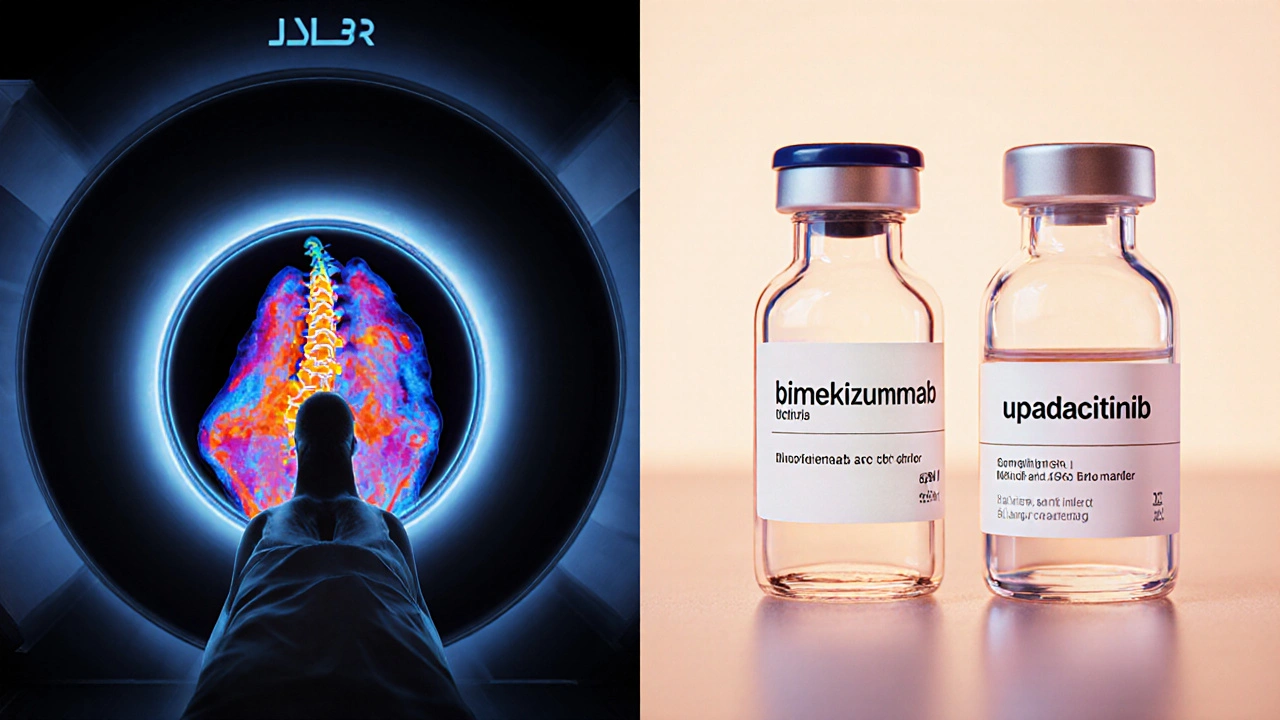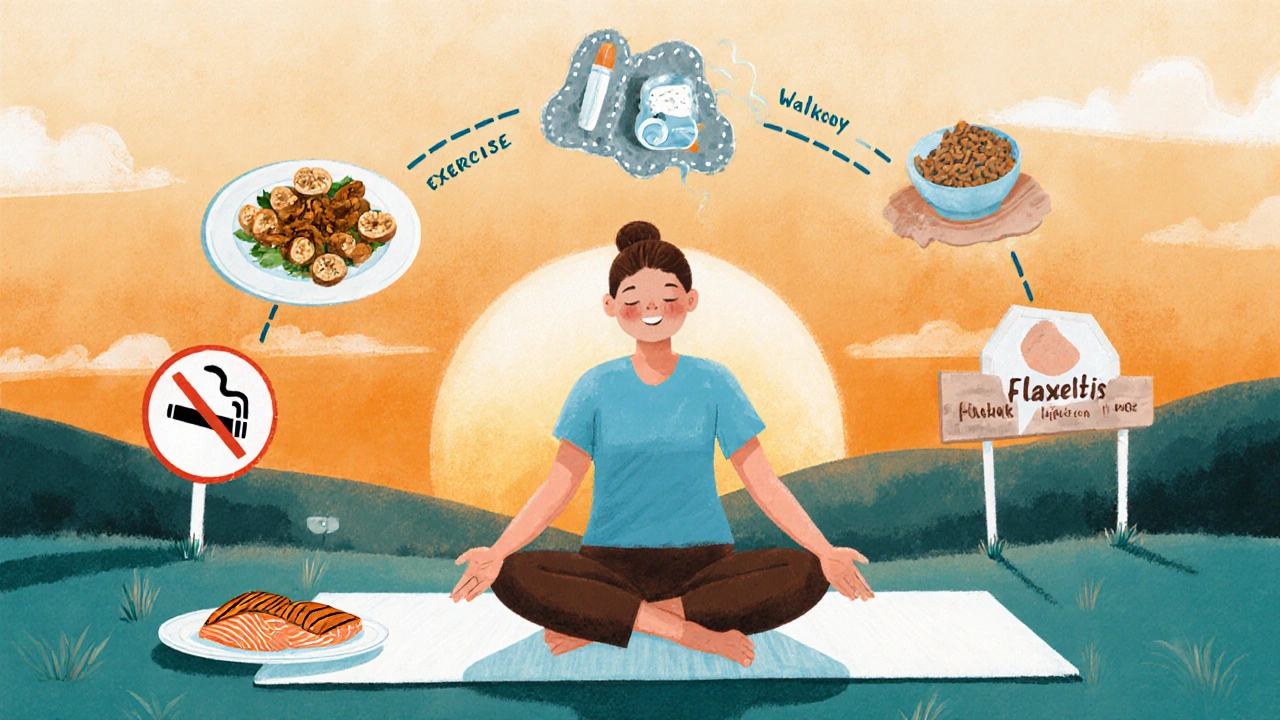Ankylosing Spondylitis Treatment Comparison Tool
- Administration: Subcutaneous injection every 4 weeks
- Onset of Pain Relief: 4–6 weeks
- ASAS40 Response Rate: 65%
- Major Safety Concern: Oral candidiasis (~5%)
- Effect on Radiographic Progression: Reduced new syndesmophyte formation by 40%
- Administration: Oral tablet once daily
- Onset of Pain Relief: 2–3 weeks
- ASAS40 Response Rate: 58%
- Major Safety Concern: Thromboembolism risk in high-risk patients
- Effect on Radiographic Progression: Data pending – early signals promising
Consider these factors when choosing a treatment:
- Personal preference for injection vs. oral medications
- History of clotting disorders (JAK may not be suitable)
- Cardiovascular risk factors (JAK carries increased thromboembolism risk)
- Need for rapid symptom relief (JAK offers faster onset)
- Compliance and ease of administration
Treatment Recommendation Summary
For early-stage AS: Start with NSAIDs and assess response within 12 weeks.
If no ASAS40 response: Discuss escalation to either IL-17 or JAK inhibitors based on patient-specific factors.
Long-term goal: Reduce inflammation to prevent structural damage and preserve mobility.
Imagine a world where the back pain that defines ankylosing spondylitis (AS) can be halted before it ever cripples you. In the past year, scientists have uncovered trails of hope that could turn that imagination into reality. This article pulls together the most compelling data from 2024‑2025, so you can see which drugs, diagnostics, and lifestyle insights are actually moving the needle.
What’s new on the scientific front?
The flood of ankylosing spondylitis research papers in 2025 has centered on three big questions: why does the disease start, how can we stop inflammation early, and can we predict who will progress fastest. The answers are converging around genetics, the gut, and next‑generation imaging.
HLA‑B27 is a genetic marker present in up to 90% of AS patients and a key driver of mis‑folded protein stress. A 2024 multinational cohort showed that carriers with additional variants in the ERAP1 gene develop radiographic changes 2‑3 years earlier than HLA‑B27 alone. This dual‑genotype model is reshaping risk calculators used in rheumatology clinics.
At the same time, a series of gut‑microbiome studies revealed a consistent depletion of *Akkermansia muciniphila* in AS patients. Researchers at the University of Toronto linked this loss to heightened Th17 cell activity, paving the way for microbiome‑targeted therapies.
New drugs that are reshaping treatment algorithms
Biologic therapy for AS has long been dominated by tumor‑necrosis factor (TNF) blockers. While still effective, not all patients respond, and long‑term safety concerns linger. The past 18 months have introduced two fresh classes that are already changing prescribing habits.
IL‑17 inhibitors target the interleukin‑17 pathway, a downstream driver of bone formation and inflammation in AS such as secukinumab and the newer bimekizumab have shown 65% ASAS40 response rates in phase‑3 trials, with a rapid reduction in spinal pain within 4 weeks. Notably, bimekizumab blocks both IL‑17A and IL‑17F, delivering slightly higher remission odds in patients who failed TNF therapy.
Enter the JAK inhibitors small‑molecule oral agents that interfere with cytokine signaling via Janus kinases. Upadacitinib, originally approved for rheumatoid arthritis, received FDA and EMA approval for active AS in 2024 after the SELECT‑AXIS 2 trial demonstrated a 58% ASAS40 response and meaningful improvements in functional index scores. Its oral route and quick onset (average 2‑week response) have made it attractive for patients reluctant to inject biologics.
While both IL‑17 and JAK blockers are promising, safety profiles differ. IL‑17 inhibitors carry a modest increase in candidiasis risk, whereas JAK inhibitors raise concerns about venous thromboembolism in patients with cardiovascular risk factors. Shared decision‑making is now a cornerstone of AS care.

How imaging is getting sharper - the MRI revolution
Early detection hinges on seeing inflammation before it ossifies. Conventional MRI has been the workhorse, but two advances are pushing the boundaries.
Whole‑body MRI captures the entire axial skeleton in a single scan, allowing clinicians to spot sacroiliac and spinal lesions simultaneously. A 2025 multicenter study found whole‑body MRI identified early bone‑marrow edema in 30% of patients who had normal lumbar MRI, leading to earlier treatment initiation.
Second, the emergence of diffusion‑weighted imaging (DWI) quantifies water molecule movement in tissues, providing a biomarker for active inflammation versus chronic fatty changes. DWI scores correlated strongly (r=0.78) with serum C‑reactive protein levels, offering a non‑invasive way to monitor disease activity without repeated blood draws.
Comparing the newest biologics - which one fits you?
| Attribute | IL‑17 Inhibitor (e.g., bimekizumab) | JAK Inhibitor (e.g., upadacitinib) |
|---|---|---|
| Administration | Subcutaneous injection every 4 weeks | Oral tablet once daily |
| Onset of pain relief | 4-6 weeks | 2-3 weeks |
| ASAS40 response (phase‑3) | 65% | 58% |
| Major safety concerns | Oral candidiasis (≈5%) | Thromboembolism risk in high‑risk patients |
| Effect on radiographic progression (2‑yr data) | Reduced new syndesmophyte formation by 40% | Data pending - early signals promising |
Choosing between them isn’t just about numbers; lifestyle, comorbidities, and personal comfort with injections matter. Patients with a history of clotting disorders may lean toward IL‑17 blockers, whereas those who struggle with needle anxiety often prefer JAK pills.
Beyond drugs - lifestyle tweaks that amplify treatment
Even with cutting‑edge meds, a solid foundation of physical activity and nutrition improves outcomes. A 2024 randomized trial showed that a supervised yoga program combined with IL‑17 inhibition reduced Bath Ankylosing Spondylitis Disease Activity Index (BASDAI) scores by an extra 1.2 points compared to medication alone.
Dietary patterns rich in omega‑3 fatty acids (found in fatty fish, flaxseed, walnuts) have been linked to lower serum IL‑17 levels, according to a metabolomics study from Kyoto University. While not a substitute for therapy, adjusting the diet can curb flare‑ups.
Smoking cessation remains a non‑negotiable. Current smokers develop radiographic sacroiliitis twice as fast, independent of HLA‑B27 status. Clinics now incorporate nicotine‑replacement programs as part of the standard AS care bundle.

What the latest clinical trials mean for patients
Several phase‑3 studies wrapped up in early 2025, delivering hard data that will shape guidelines next year.
The BEAT‑AS trial compared bimekizumab head‑to‑head with adalimumab (a TNF blocker) in 842 patients. Not only did bimekizumab achieve higher remission rates, but MRI‑based DWI scores decreased 35% more than the TNF arm, suggesting superior control of subclinical inflammation.
Meanwhile, the SELECT‑AXIS 2 trial (upadacitinib) provided a thorough safety overview: 4% of participants experienced serious infections, comparable to TNF inhibitors, while the incidence of major cardiovascular events stayed under 1%-a reassuring figure for older patients.
These results are already nudging the 2026 AS treatment algorithm toward a “treat‑to‑target” model, where early escalation to IL‑17 or JAK therapy is recommended if patients don’t reach an ASAS40 response within 12 weeks of NSAID therapy.
Putting it all together - a patient‑centered action plan
- Confirm diagnosis with whole‑body MRI and DWI if early disease is suspected.
- Test for HLA‑B27 and ERAP1 variants to refine prognosis.
- Start NSAIDs while arranging a rheumatology appointment.
- If no ASAS40 response at 12 weeks, discuss stepping up to an IL‑17 or JAK inhibitor, weighing injection vs pill preferences and safety profile.
- Integrate a regular low‑impact exercise regime (yoga, swimming) and consider omega‑3‑rich diet.
- Quit smoking and manage weight to slow radiographic progression.
- Schedule MRI/DWI follow‑up at 12‑month intervals to track silent inflammation.
Following this roadmap can shrink pain, preserve mobility, and possibly halt the bone‑building process that characterizes advanced AS.
Frequently Asked Questions
How soon can new biologics stop spinal fusion?
Long‑term data (up to 2years) for IL‑17 blockers show a 40% reduction in new syndesmophyte formation compared with TNF inhibitors. JAK inhibitors are still being followed, but early imaging signals suggest they may also slow bone growth.
Are oral JAK inhibitors safe for older adults?
They are generally well‑tolerated, but clinicians screen for cardiovascular risk, a history of clotting, and liver function before prescribing. The SELECT‑AXIS 2 trial reported <1% serious heart events, comparable to TNF blockers.
Can diet really influence AS activity?
While diet isn’t a cure, studies link higher omega‑3 intake with lower IL‑17 levels, and low‑fiber diets appear to worsen gut dysbiosis linked to inflammation. Adding fish, flaxseed, and leafy greens can complement medical therapy.
Is whole‑body MRI covered by insurance?
Coverage varies by country and insurer. In Australia and the US, many private plans reimburse whole‑body MRI when standard MRI fails to explain symptoms, especially if a rheumatologist documents the need for early detection.
What’s the difference between ASAS40 and ASAS20 responses?
ASAS40 means a 40% improvement in at least three of four disease domains (pain, function, inflammation, patient global) and no worsening in the remaining domain. ASAS20 is a 20% improvement. ASAS40 is the benchmark for high efficacy in trials.


Rahul yadav
Wow, reading about the IL‑17 and JAK breakthroughs feels like witnessing a medical revolution unfold before our eyes 😮! The quick onset of pain relief with upadacitinib could be a game‑changer for those battling relentless morning stiffness. Equally, bimekizumab’s dual IL‑17A/F blockade offers a promising shield against new syndesmophyte formation. Imagine patients finally getting back to dancing at weddings without fearing a permanent curvature 🕺. Let’s keep the hope alive and share these advances with anyone fighting ankylosing spondylitis.